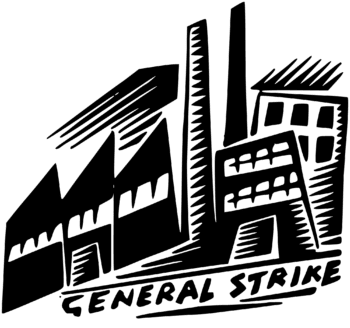
NYC (1970)
February 22, 2017
BY JASON PRAMAS @JASONPRAMAS
You know we live in interesting times when general strikes get discussed matter-of-factly in an American big city newspaper. A subject which would have only been raised in a publication like the Boston Globe in recent decades to attack it.
But to give the Globe’s Shirley Leung—an occasional target of my ire—credit where it’s due, she did just that in her recent column about three calls for general strikes against the policies of the Trump administration. One fairly small, hastily organized “Day Without Immigrants” strike last Thursday, and two upcoming one-day strike calls: “A Day Without a Woman” on March 8 (International Women’s Day), and a second “Day Without Immigrants” on May 1 (May Day, the international workers’ holiday) that are likely to be much larger affairs.
It’s fairly obvious why Leung is suddenly interested in the strongest tactic in labor’s arsenal. She’s a bit of a feminist and was supportive of Hillary Clinton, and like many people fitting that description is now considering political action that would have been unthinkable for her only three months agone. That’s fine. She gets some things wrong, but interviews some experts that know their stuff, and does her audience a service by discussing the concept of a general strike at all.
To review, a strike occurs when working people withhold their labor for any reason. A general strike occurs when massive numbers of workers from more than one industrial sector withhold their labor in a city, state, region, or nation. The difference is that a strike is typically called to demand redress in a single workplace or industry. A general strike is called to cause serious economic disruption aimed at bringing corporations and the government to their knees on a single issue, a group of issues, or even to overthrow the current political economic system itself. US strikes are usually called by labor unions, general strikes by coalitions of labor unions and left-wing political groups.
The problem for organizers considering the tactic is that general strikes are basically illegal. At least for labor unions. Leung briefly mentions that the Oakland General Strike of 1946 was the “last” general strike. But she didn’t say why. Turns out that the main reason there have been no “official” general strikes since then is because the Oakland action was part of the massive five-million worker national strike wave of 1945-46—in total, the largest sustained protest of any kind in American history. The strike wave won some victories. Then triggered a political backlash by a coalition of major corporations and right-wing legislators, leading directly to the passage of the anti-labor federal Taft-Hartley Act of 1947. The law specified a number of political economic tactics unions were henceforth banned from using, including: jurisdictional strikes, wildcat strikes, solidarity or political strikes, secondary boycotts, secondary and mass picketing. Long story short, those types of strikes, boycotts, and pickets translate to a general strike. Not that the many general strikes prior to 1947 were treated as legal either, but after 1947 there was little ambiguity as to their legality.

Does that mean that the American labor movement just rolled over? No. It took decades for corporations and their political allies to crush it down to the diminished state it languishes in today—when only 10.7 percent of the US workforce is unionized (down from a high of almost 35 percent in 1954). And does that mean that there have been no actions like a general strike since 1946? Again, no. There have been subsequent general strikes if you include the major wildcat strikes of the 1970s and accept that the 2006 immigrant boycott (that Leung does mention) was essentially a general strike in some cities.
Wildcats are strikes organized by union workers against their employers … and two forces that often collude with bosses: the government and their own union leadership. The most recent major wave of wildcat strikes occurred in the 1970s. Some of them were large enough in some locales to be considered general strikes—especially where strikers drew support from other unions. Particularly the 1970 National US Postal Workers Wildcat Strike (200,000 workers in 15 states), the 1970 Teamsters Wildcat Strike (500,000 workers, mostly east of the Mississippi River), and the 1974 Wildcat Miners Strike (26,000 workers in West Virginia and Virginia). Some of the wildcats dragged on for weeks. For comparison, the Oakland General Strike involved 100,000 workers over a couple of days (although it wasn’t called as a traditional strike, and had elements of a wildcat).
As for the 2006 May Day immigrant action, “The Great American Boycott,” its title in Spanish was “El Gran Paro Estadounidense”—meaning “The Great American Strike.” In practice, as it involved multi-industry boycotts and strike actions, the 2006 mass walkout for immigrant rights can be viewed as a general strike. Over 1.5 million people participated. But since they were mostly immigrants, many American citizens, Leung included, don’t think of it as a strike at all. Certainly it wasn’t as strong as the 1945-46 strike wave, or the 1970s wildcat strikes. But in immigrant cities like LA and Chicago it definitely had significant political and economic impact. If it had gone on longer than a few days, many citizens would likely have felt those effects nationwide.
So the question is: Will the upcoming one-day strike calls have as powerful a political economic effect as a classic general strike? Probably not. In that case, will they be as powerful as a major wildcat strike? Not just yet. How about the 2006 Great American Boycott by immigrants? Will they be that big? That’s probably the sweet spot. The recent Women’s Marches were able to pull an estimated minimum of 3.3 million people out on a weekend when many participants weren’t working. Do a third of those numbers on a workday, and you’ve reached the lower estimate for the 2006 immigrant strike.
Frankly, both the March 8 and May 1 strike calls could be big. Both are aimed at constituencies that have demonstrated ability to turn out in large numbers. And neither call is led by labor unions that can’t easily call general strikes; so there is an opening to do so. But they will only be powerful to the extent that they threaten the established political order. And there the differences between the two events become clear. The March 8 Day Without a Woman strike is being called by some of the same forces that organized the Women’s Marches in January. Forces that, as I’ve previously written, are directly connected to the neoliberal Clintonite wing of the Democratic Party. Folks who just lost an election because they refused to put working people’s needs over corporate profits.
But the May 1 Day Without Immigrants strike call is being organized by Movimiento Cosecha—a fast-growing coalition of militant young left-wing immigrant organizers. They are potentially limited by their focus on immigrant communities. However, they were recently screwed by the Democratic Party and the Obama administration—which both failed to respond to their demand that all 11 million undocumented immigrants be granted legal status before Trump came into office. So they are less likely to heed the siren call of Democratic leaders to tone down their protests when they become inconvenient for the Dems’ corporate backers, and therefore far more likely to actually build their May Day effort into something approaching a general strike than the March 8 organizers are.
Their call to action makes that intent quite clear:
One day is just the beginning of a season of strikes and boycotts. We know that each time we strike for a day, we will build power. And the more days we strike, the stronger we will feel. The more desperate those in power become. The more the elite will want business to return to normal. They will be forced to figure out a way to give us permanent protection. And in the process, we will win the dignity and respect that we deserve and demand.
Ultimately, debates over whether major work stoppages are “real” general strikes aren’t the point. What matters is “boots on the ground,” and the ability of organizers to translate their numbers into political and economic gains. Any coalition that can pull millions out of work and into the streets against the Trump administration will write a new chapter in both American political and labor history. Which could be just the game changer our incipient movements for democracy need. But if there turns out to be more than one such coalition, so much the better.
Apparent Horizon is syndicated by the Boston Institute for Nonprofit Journalism. Jason Pramas is BINJ’s network director and senior editor of DigBoston.
Copyright 2017 Jason Pramas. Licensed for use by the Boston Institute for Nonprofit Journalism and media outlets in its network.
Check out the Apparent Horizon Podcast on:
iTunes, Google Play Music, Blubrry, Stitcher, TuneIn, and YouTube
